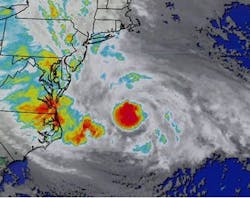It seems like every time we experience another natural disaster some people have already forgotten the lessons we learned from the last one. It's all the more exasperating when you realize how simple some of these basic preparedness "lessons" are. Let's review a few of these lessons and contemplate (perhaps) a few new ones.
A little rain never hurt anyone, but a lot of it can kill you.
That was one of my favorite lines from the movie "Jumanji." In some parts of the mid-Atlantic states they received over sixty hours of rain with rainfall totals upwards of eleven inches. Let's try to put that into some kind of perspective we might be able to visualize.
In a previous article about the value of rain barrels (for another site) I did the math about square footage on my roof, how many square inches that is, etc. What I found out was that collection the water from just ONE of my downspouts during a rainfall that totaled just 1/4" would fill eight of my 50-gallon rain barrels (if I had that many). So, let's expand on that...
My total roof area is approximately 2,000 square feet. At 144 square inches per square foot that's 288,000 square inches. If eleven inches of rain fell, that's 3,160,000 cubic inches of rain. (Read that again: over three MILLION cubic inches.) Divide that by 231 cubic inches of liquid per gallon and you get (rounded to nearest whole gallon) 13,714 gallons of water. How do we visualize that?
Well, you know those pools that are round and have an inflatable ring around the top and as you fill the pool the ring rises until you've filled it all the way? 13,714 gallons of water is enough to fill one of those pools over four and a half feet deep if the pool was twenty-four feet in diameter (across). Picture that: 24 feet across, round, 4.5 feet deep. Is that enough to drown someone? Certainly.
Now, imagine taking out a nice sharp knife and slicing that pool open on the downhill side as fast as you can. As the 13,000+ gallons of water rush out, do you think it's enough to wash you away? It's certainly enough to knock you off your feet and move you a distance. Keep that thought in mind as we do one more little bit of math. My neighborhood has about 4,400 homes in it averaging (I'm guessing) about a 1,500 square foot area per roof (about 75% of mine). That 11" rain fall would therefore be about 10,275 gallons per roof OR over 45,000,000 gallons of water total. Remember that number does not include all of the ground space between houses, roadways, etc. That 45 MILLION gallons of water has to flow somewhere and it tends to go downhill through geographically existing channels. We humans tend to build roads that go across or into those natural channels and then we're even sometimes dumb enough to attempt to drive through that rushing water when we come upon it. Why? Because driving the long way around would be too inconvenient OR we simply have to if we want to get to where we're going. If you find yourself in that position, ask yourself this one question: Is getting to your destination worth dying for? If not, turn around.
A slight breeze is nice, but hurricane strength winds for hours... not so much.
Sure, a nice summer breeze, spring breeze or autumn breeze feels nice. That said, even a five mile per hour breeze on a cold day can make you feel a chill. A sixty mile per hour breeze isn't... it's a wind. In my local area we have two high bridges, both of which get closed if the wind gusts over 55 mph. We humans tend to let our feeling of power go to our heads and we sometimes forget just how powerful Mother Nature can be. That sometimes angers her and she reminds us.
What we need to remember is that although a breeze can feel nice, a wind can knock us down, move us around, or blow other things into us. Blown with enough force, those projectiles can severely injure or kill us, and that same wind can throw us into other objects with enough force to smash us. Taking protection in a vehicle is no protection. Remember and live by the lessons you learned in grade school: go to the lowest level of your house; below ground basement is best. If that's not an option, go to the center-most room of your house.
Mother Nature is more powerful than man and all of our contrivances.
In every weather disaster I've seen reported for the past couple of decades, Mother Nature has found a way to overcome some preparation made by man. The best example I can think of is how rain from Hurricane Katrina flooded the New Orleans Emergency Operations Center early on.
Another thing we forget is that Mother Nature isn't just comprised of weather but includes all of the forces our Earth creates including gravity. Sometimes our structures, wonderfully designed to be secure in pouring down rain and more than capable of supporting themselves against gravity are insufficiently designed and constructed to resist that rain, plus gravity, plus high winds. Almost every structure can sway and if it sways enough then the center of gravity changes and the structure comes tumbling down.
I'm actually surprised this doesn't happen more often. I suppose it's a good thing that we over-engineer so much.
Bugging out or bugging in?
I can't begin to count the number of articles I've written about Bugging Out, Bug Out Bags, prepping to But Out, etc. The number of conversations about such have been even more. It's a rare occasion that I find myself discussing "Bugging In" or "Hunkering down." I find that odd given that I've only left my residence once in the past decade due to an on-coming storm.
That said, whether you're bugging out or hunkering down, planning and preparation are both required. It is reasonable to assume that a storm of sufficient size to make you contemplate bugging out is of sufficient size to impact your safety, comfort and convenience if you hunker down and ride it out. Power loss... loss of running water... damage to your shelter... loss of convenient food supplies... all of these things should be expected and planned for.
If you bug out you have to pack to provide yourself with shelter, food, water, first-aid and defense. Planning to hunker down should include each of those items as well. PLAN on the conveniences to fail and be prepared to provide for yourself and your family as necessary.
Being prepared for a long camping trip almost equates to being prepared to survive.
I have previously compared camping to bug out practice. I maintain that approach. If you can camp comfortably for a week or more, then I'd consider you relatively well prepared to survive without modern conveniences for a week or more. If you have that much food to camp, then you have that much food to survive.
Just as going on a long camping trip can be excellent practice for bugging out, shutting off your modern conveniences for a couple days can be good practice for when it happens unexpectedly. So, prior to a future weather event, store food and water, prep your first-aid supplies and make sure you've covered all your bases. Then turn off the main switch in your breaker box and turn off the water to your house. See how well you do for how long. You're not practicing replacing comfort. You're practicing survival. Know the difference.
The freaks come out at night... and in the morning, afternoon and evening.
As much as the best of mankind can be brought out by challenges we face after weather disasters, so can the worst. In fact, prior to Hurricane Sandy hitting NJ and NY, Twitter feeds were used by gangs to plan looting and robbing events once the hurricane had passed. It is important to note that if you're properly prepared, there are probably ten people out there who aren't and it's also a safe bet that one or two of them are predators. That means they're more than willing to come do you harm to take what you've got that they want.
The only protection against this, especially when emergency circumstance has public safety services WAY backed up, is to be prepared to defend yourself, your family and your property. Part of that preparation means knowing the laws in your area so you are fully informed as to what you can or can't legally do. Further preparation includes arming yourself and training so that you can deliver authorized force accurately.
Stay safe!



